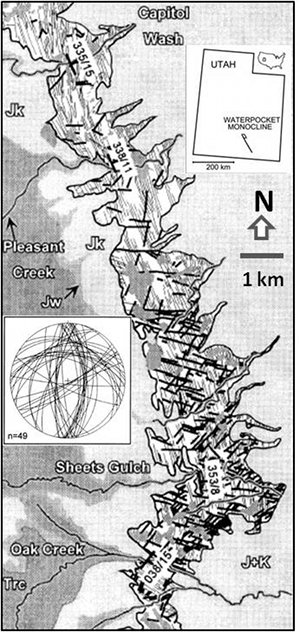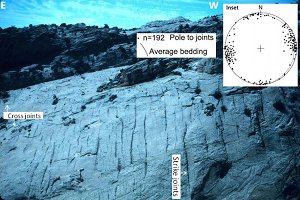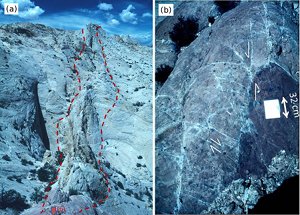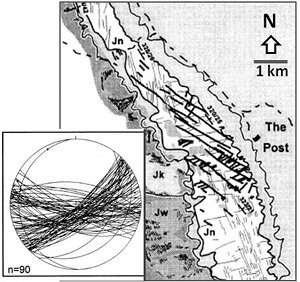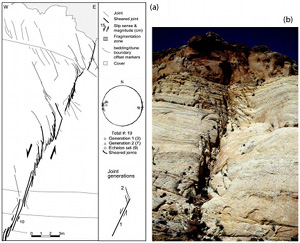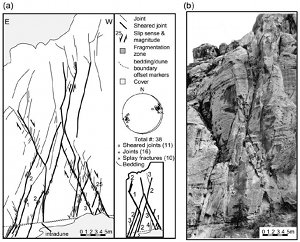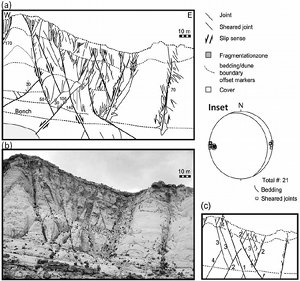| |||||||||
|
|
|||||||||
|
|
|||||||||
| Fractures in Waterpocket Monocline, UT, USA | |||||||||
|
The Waterpocket fold is one of many basement involved Laramide structures of upper Cretaceous to Eocene age which occur throughout the Colorado Plateau. It is a N-S trending monoclinal flexure of about 100 miles long in south-central Utah (Figure 1 and Figure 2). Similar to many other monoclines of the Colorado Plateau, it is attributed to sedimentary cover response to a high-angle basement fault of probably reverse kind (Morris et al., 2000). The core of the monocline occurs primarily in the Jurassic sandstones known as the Glen Canyon Group which includes from oldest to youngest the Wingate, Kayenta, and Navajo (Figures 1 and 2). The older two are primarily fluvial and the youngest is typically an aeolian deposit.
Aside from the main monoclinal flexure in the sedimentary cover, there is a wide variety of structures including faults, joints and deformation bands exposed along and across the fold (Davis, 1999; Roznovsky and Aydin, 2001; Davatzas and Aydin, 2003). The previous studies have documented joints dominated by the monocline-axis parallel or along-strike set (Figure 3) though joint sets in other orientations are also present. Faults are also common along and across the monocline. We here distinguish between two different types of faults: deformation band or more precisely shear band type and those developed from shearing of primarily the monocline parallel joints. We also note local bedding plane faults and related splay fractures.
The shear band type faults such as that in Figure 4a are more common in the Navajo Sandstone. Figure 4(a) shows tpical high-relief of the shear band faults (Aydin and Johnson, 1978; Davis, 1999) and Figure 4(b) which is an annotated photo (bird's eye view) of an area at the south end of the image of the same fault zone with a Riedel type ladder structure (Davis, 1999; Katz et al., 2004) composed of a dominant left-lateral offset along the northerly trending set and a right-lateral offset along the northwesterly trending set. Notice that the red unit close to the viewer in the lower right corner is offset left-laterally for larger than 2 meters. Figure 5 is a highly accurate map of the Sheets Gulch area by George Davis and his students showing the pattern and other attributes of such a system in the Sheets Gulch area along the monocline. The pattern appears to be conjugate with the acute intersection angle between the left-lateral and right-lateral sets pointing in the direction approximately perpendicular to the monocline axis. The faults are generally of strike-slip but dip-slip components are also present. As will be pointed in the mechanisms and mechanics section, there is a strong correlation between the concentration of the shear band faults and the complexities along the monocline geometry as indicated by Figure 6. The other type of faults developed from successive shearing of joints, predominantly parallel to the axis of the monocline, splay fracturing, and shearing of the splay fractures. These faults are of normal sense and have an apparent conjugate pattern but the acute angle between the two complementary sets point the vertical direction. By examining field cases of incipient, moderate, and well-developed faults particularly in cross-sections, the temporal and spatial evolution of the hierarchical faults developed this way can be elucidated. At the incipient stage of faulting (Figure 7), which accommodates slip from millimeters to centimeters, faults are composed of two structural elements: sheared joints and splay joints (Davatzes and Aydin, 2003) . Sheared joints were initial joints which reactivated in shearing, with traces paralleling to those of monocline-parallel joints observed throughout the park. Splay joints abut at an oblique angle (kink angle) against the sheared joints and typically occur at or near the tips of the sheared joints. Even at this incipient stage, it is possible to detect minute amount of shearing across some of the splay joints (see those at the central part of the fault). Moderately developed fault systems (Figure 8) are characterized by an 'apparent' conjugate fault pattern, which is composite of two sets of faults with opposite dip (see discussion under the Apparent Conjugate Pattern). The mature faults occur in zones with tens of meters wide and have cumulative offset of a few meters. In this particular example, four generations of joints or sheared joints are observed (see the annotated drawing in the lower corner of Figure 8). In all cases, younger sets of joints have smaller offsets than older ones. Individual sheared joints in the older generations have up to about 25 cm offset, while those of the 4th generation fractures are just splays and lack shear offset. Well-developed fault zones, such as that shown in Figure 9, has a zone, the width of which reaching about 120 meters and cumulative offset of several meters. Figure 10 shows a conceptual diagram showing deformation of a sandstone-shale sequence representing the Glen Canyon group in the Capitol Reef area by bending and extension of massive sandstone formations due to an underlying high-angle dip-slip fault. It is possible to find evidence for bed-parallel faults located along the sandstone -shale (or thinly bedded sandstone and shale) units. Following the deformation by shear band faults, the younger generation of faulting occurs by shearing of monocline axis-parallel joints (1 to 4 in the diagram). This age relationship can be deduced from the joint sets and the sheared joint-based faults cutting across the shear band faults as shown by the photo in joints-deformation bands assemblage section; Back to the conceptual diagram in Figure 10, (1) represents jointing, (2) shows the splay fracturing, and (3) and (4) depict the development of two sets of normal faults with an apparent conjugate pattern. It is possible that bending and tilting of the beds in response to incremental movement across the underlying faults provides the mechanism for sequential shearing of the multiple generation of fractures. | |||||||||
| Reference: |
|||||||||
| Aydin, A., Johnson, A.M., 1978 Davatzes, N.C., 2003 Davatzes, N.C., Aydin, A., 2003 Davis, G.H., 1999 Katz, Y., Weinberger, R., Aydin, A., 2004 Morris, T.H., Manning, V.W., Ritter, S.M., 2000 Roznovsky, T., Aydin, A., 2001 |
|||||||||
|
Readme | About Us | Acknowledgement | How to Cite | Terms of Use | Ⓒ Rock Fracture Knowledgebase |
|||||||||
